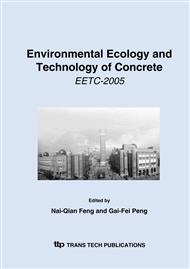p.223
p.230
p.235
p.242
p.248
p.255
p.263
p.269
p.275
Study on Abilities of Mineral Admixtures and Geopolymer to Restrain ASR
Abstract:
This paper deals with the effect of mineral admixtures and Geopolymer on preventing excessive expansion due to alkali-silica reaction (ASR). The test method used was ASTM C 441-97. Expansions of mortar-bars were measured at 14, 56, 90 days. The results prove that mineral admixtures can effectively restrain ASR. When three kinds of mineral admixtures, silica fume, fly ash, and ground granulated blast-furnace slag (GGBS), were used together, they bring about a compound effect which is more effective to restrain ASR. Mortar expansion can be reduced 81.9 % by this compound effect. Chemical analysis of the pore solution shows that mineral admixtures reduced concentrations of hydroxyl, potassium and sodium ion, so that damages from ASR decreases. Geopolymer, an amorphous inorganic material, was prepared with metakaolin and other mineral admixtures in the condition of high pH. Alkalis fixed in the framework of Geopolymer, there are no enough alkalis to react with active aggregates. Geopolymer does not generate any dangerous alkali-silica reaction even with alkali contents as high as 12.1 %.
Info:
Periodical:
Pages:
248-254
Citation:
Online since:
January 2006
Authors:
Price:
Сopyright:
© 2006 Trans Tech Publications Ltd. All Rights Reserved
Share:
Citation:


